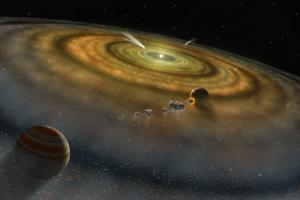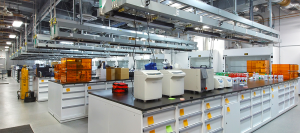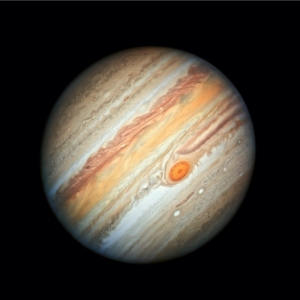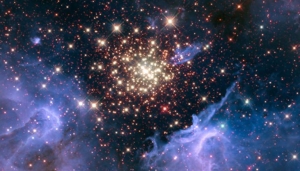LAB REPORT
Science and Technology Making Headlines
Jan. 24, 2020


Artist's conception of the dust and gas surrounding a newly formed planetary system. Image courtesy of NASA.
Giant planets have a blast
An early frenzy shaped our solar system. Sometime after the planets took shape from primordial gas and dust, resonant tugs between the giant planets threw their orbits out of kilter. The gravity of the errant giants blasted Pluto and its many icy neighbors into the far-out Kuiper belt. The instability also scattered oddball moons and asteroids and triggered smaller bodies to pummel the inner planets.
Now that scenario is experiencing some upheaval of its own.
Scars on the moon had convinced many planetary scientists that the storm hit about 3.95 billion years ago, 650 million years after the solar system formed. But this model has long had a flaw: Mercury, Venus, Earth and Mars would likely not have survived such a late assault. And over the past few years, a new timeline has begun to emerge, one that shifts the chaos earlier, to less than 100 million years after the system’s creation — and perhaps as few as 10 million years.
“The details are strongly debated,” said Thomas Kruijer, a geochemist at Lawrence Livermore National Laboratory. There’s little direct evidence for such an early instability, and at least two other scenarios that could explain how the rocky planets survived.
Kruijer says a bombardment within the first 100 million years of the solar system is plausible. Perhaps the best evidence for it is found near Jupiter. There, following Jupiter in its orbit, spins a binary asteroid named Patroclus-Menoetius. The icy composition of its two bodies indicates they formed in the far reaches of the solar system and were implanted into Jupiter’s wake during the instability.
The hunt is on for more observations that can parse what happened during those first 100 million years, whether from asteroid samples, clusters of primordial asteroid families, or craters on the moon and Mars.


The wet lab at LLNL’s new Advanced Manufacturing Laboratory.
Advancing manufacturing
Lawrence Livermore National Laboratory (LLNL) hosted a dedication ceremony this week for its Advanced Manufacturing Laboratory, a state-of-the-art collaborative facility situated in the Livermore Valley Open Campus.
The facility, costing $10 million and sized at 14,000 square feet, features advanced 3D printing equipment and is designed to address manufacturing challenges through the merger of LLNL’s science and engineering expertise with academia and industry, leading to the creation of public-private partnerships.
LLNL has exhibited a significant output toward additive manufacturing research. The facility aims to leverage its experience in precision engineering, materials science and high-performance computing to help advance the field of 3D printing. As such, researchers from the facility have consistently attempted to push the boundaries of the technology.

The potential future effects of global climate change include more frequent wildfires, longer periods of drought in some regions and an increase in the number, duration and intensity of tropical storms. Credit: Left - Mellimage/Shutterstock.com, center - Montree Hanlue/Shutterstock.com.
Decade is hot, hot, hot
2019 was the second-warmest year since scientists began taking temperatures in 1880, according to a new study.
The near-record temperatures cemented the last decade’s title as the warmest in modern human history, according to data from NASA and the National Oceanic and Atmospheric Administration. Each of the last five years was among the five warmest years on record, NASA said.
Earth’s climate has experienced natural variation over long time scales, but the speed and ferocity of global warming since the 19th century have been anything but natural.
Benjamin Santer, an atmospheric scientist at Lawrence Livermore National Laboratory, said researchers have gone to great lengths to tease out how various natural phenomena leave their mark on the planet’s climate dynamics.
“And the message from that climate fingerprinting, from the pattern analysis, is nature couldn’t do this,” Santer said. “No combination of natural cycles, changes in the sun’s energy output, recovery from volcanic eruptions, could generate the observed changes.”


LLNL scientists have created the pressures similar to what is found in the center of Jupiter to create the densest form of copper on the planet. Image courtesy of NASA, ESA, A. Simon (Goddard Space Flight Center), and M.H. Wong (University of California, Berkeley).
Putting the pressure on copper
There are places in space where truly extreme pressures exist. But normally you find them in the centers of planets where we do not usually visit. That is why the realm of extreme pressures still is pretty mysterious. But how do common materials look in those conditions?
You must first have extreme devices such as the National Ignition Facility (NIF) at the Lawrence Livermore National Laboratory (LLNL). Recently, the scientists there took tiny pieces of copper thinner than a human hair and then put them under all the pressure they had available.
Dayne Fratanduono from LLNL and his colleagues pressed the copper under an unimaginable 30 million atmospheres. For just an inconceivable amount of time – just a billionth of a second. This extreme treatment made the density of the copper three times as much. And for a moment the copper became the densest object on the planet.


A region of star births nestled within the ingredients needed for star formation: clouds of interstellar gas and space dust. The nebula resides 20,000 light-years away in the constellation Carina. It contains a central cluster of huge, hot stars. Image courtesy of Hubble Heritage Team/NASA/ESA.
Older than dirt
You could say that the stardust emitted from the Murchison meteorite is older than dirt and a lot older than our solar system.
New analysis shows that that stardust is from 5 to 7 billion years old. By comparison, our solar system formed about 4.5 billion years ago.
Stardust grains are the oldest datable solid samples available for study in the laboratory and provide invaluable insight into the presolar chronology of our galaxy. Previous studies showed that stardust grains formed up to 1 billion years prior to the formation of our solar system.
“However, the finding that roughly 8 percent of the analyzed grains are actually older than 1 billion years is definitely surprising,” said LLNL scientist Reto Trappitsch, a co-author of the new research. “So far, we thought that 1 billion years is about the maximum possible age such a small grain might survive the harsh conditions in the interstellar medium, however, it seems that we have to revise our image. This result is really great though, since it means that by analyzing stardust grains for their nucleosynthetic signatures, we actually study a broader time range than we previously expected.”





